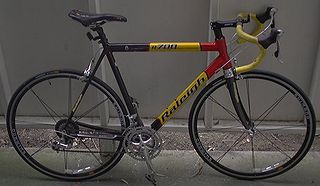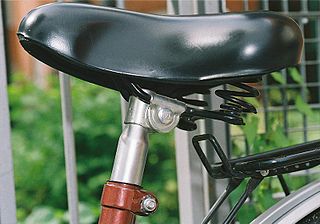
A bicycle, also called a bike or cycle, is a human-powered or motor-powered, pedal-driven, single-track vehicle, having two wheels attached to a frame, one behind the other. A bicycle rider is called a cyclist, or bicyclist.

A mountain bike or mountain bicycle is a bicycle designed for off-road cycling. Mountain bikes share similarities with other bicycles, but incorporate features designed to enhance durability and performance in rough terrain. These typically include a front or full suspension, large knobby tires, more durable wheels, more powerful brakes, straight handlebars, and lower gear ratios for climbing steep grades.)

A bicycle frame is the main component of a bicycle, onto which wheels and other components are fitted. The modern and most common frame design for an upright bicycle is based on the safety bicycle, and consists of two triangles: a main triangle and a paired rear triangle. This is known as the diamond frame. Frames are required to be strong, stiff and light, which they do by combining different materials and shapes.

A bicycle wheel is a wheel, most commonly a wire wheel, designed for a bicycle. A pair is often called a wheelset, especially in the context of ready built "off the shelf" performance-oriented wheels.
The Cannondale Bicycle Corporation is an American division of Canadian conglomerate Dorel Industries that supplies bicycles. It is headquartered in Wilton, Connecticut with manufacturing and assembly facilities in China.
Trek Bicycle Corporation is a bicycle and cycling product manufacturer and distributor under brand names Trek, Electra Bicycle Company, Bontrager, and Diamant Bikes. The company has previously manufactured bikes under the Gary Fisher, LeMond Racing Cycles, Klein, and Villiger Bikes brand names. With its headquarters in Waterloo, Wisconsin, Trek bicycles are marketed through 1,700 independently owned bicycle shops across North America, subsidiaries in Europe, Asia, South Africa, as well as distributors in 90 countries worldwide. Most Trek bicycles are manufactured outside the United States, in countries including the Netherlands, Germany, Taiwan and China.

A racing bicycle, also known as a road bike, and once popularly known as a ten speed, is a bicycle designed for competitive road cycling, a sport governed by and according to the rules of the Union Cycliste Internationale (UCI). The UCI rules were altered in 1934 to exclude recumbent bicycles.

The headset is the set of components on a bicycle that provides a rotatable interface between the bicycle fork and the head tube of a bicycle frame. The tube through which the steerer of the fork passes is called the head tube. A typical headset consists of two cups that are pressed into the top and bottom of the headtube. Inside the two cups are bearings which provide a low friction contact between the bearing cup and the steerer.
Colnago Ernesto & C. S.r.l. or Colnago is a manufacturer of high-end road-racing bicycles founded by Ernesto Colnago near Milano in Cambiago, Italy. Instead of following his family's farming business, Ernesto Colnago chose to work in the cycle trade, apprenticing first with Gloria Bicycles at 13, subsequently taking up road racing. After a bad crash ended his racing career, he began subcontracting for Gloria, opened his own shop in 1954, building his first frames the same year. While building frames, he remained much in demand as a racing mechanic. He was second mechanic on the Nivea team Giro d'Italia under Faliero Masi in 1955, eventually being employed as head mechanic for the Molteni team of Belgian cycling legend Eddy Merckx in 1963.

A bicycle seatpost, seatpin, saddlepole, saddle pillar, or saddle pin is a tube that extends upwards from the bicycle frame to the saddle. The amount that it extends out of the frame can usually be adjusted, and there is usually a mark that indicates the minimum insertion. Seatposts can be made of steel, aluminum, titanium, carbon fiber, or aluminum wrapped in carbon fiber.

A roadster bicycle is a type of utility bicycle once common worldwide, and still common in Asia, Africa, Latin America, and some parts of Europe. During the past few decades, traditionally styled roadster bicycles have regained popularity in the Western world, particularly as a lifestyle or fashion statement in an urban environment.
Keith Bontrager is a motorcycle racer who became a pioneer in the development of the modern mountain bike. Between 1980 and 1995, he was president of his own Bontrager Company, which continues to develop components for Trek Bicycle Corporation after Trek bought out Bontrager.
Ibis Bicycles is a mountain bike manufacturer located in northern California. It produces the popular Mojo mountain bike frame among other models. Ibis products are distributed in 33 countries.
Reynolds Technology is a manufacturer of tubing for bicycle frames and other bicycle components based in Birmingham, England established in 1898.

Aluminium alloys are alloys in which aluminium (Al) is the predominant metal. The typical alloying elements are copper, magnesium, manganese, silicon, tin and zinc. There are two principal classifications, namely casting alloys and wrought alloys, both of which are further subdivided into the categories heat-treatable and non-heat-treatable. About 85% of aluminium is used for wrought products, for example rolled plate, foils and extrusions. Cast aluminium alloys yield cost-effective products due to the low melting point, although they generally have lower tensile strengths than wrought alloys. The most important cast aluminium alloy system is Al–Si, where the high levels of silicon (4.0–13%) contribute to give good casting characteristics. Aluminium alloys are widely used in engineering structures and components where light weight or corrosion resistance is required.

Lugged steel frame construction is a method of building bicycle frames using steel tubing mated with socket-like sleeves, called lugs. For most of the bicycle's history, steel has been the primary material for bicycle frames, with lugged construction the primary assembling method. Steel continues in use by builders of high-quality steel frames, though its dominance as a frame material has waned since the mid-1990s displaced largely by aluminum and carbon fiber; lugging has been displaced by TIG welding.

Litespeed is a U.S. bicycle manufacturer founded in 1986 in Ooltewah, Tennessee. Litespeed makes titanium and carbon fiber frame road racing bicycles and mountain bikes. Titanium bicycle frames are famed for their ride quality. Litespeed, along with triathlon specific bicycle manufacturer Quintana Roo, is a subsidiary of the American Bicycle Group.

A downhill bike is a full suspension bicycle designed for downhill cycling on particularly steep, technical trails. Unlike a typical mountain bike, durability and stability are the most important design features, compared to lighter, more versatile cross-country bikes. Downhill bikes are primarily intended for high speed descent, and downhill riders will usually push, or shuttle via chairlifts or motorized vehicles, to the trailhead. Downhill bikes share similarities with freeride bikes due to their large strong frames and increased travel.

The stem is the component on a bicycle that connects the handlebars to the steerer tube of the bicycle fork. Sometimes called a goose neck, a stem's design belongs to either a quill or threadless system, and each system is compatible with respective headset and fork designs:

3T Cycling is an Italian cycle sport company associated with many champion cyclists. It was founded in 1961 and soon won a reputation for lightweight racing cycle componentry.

















